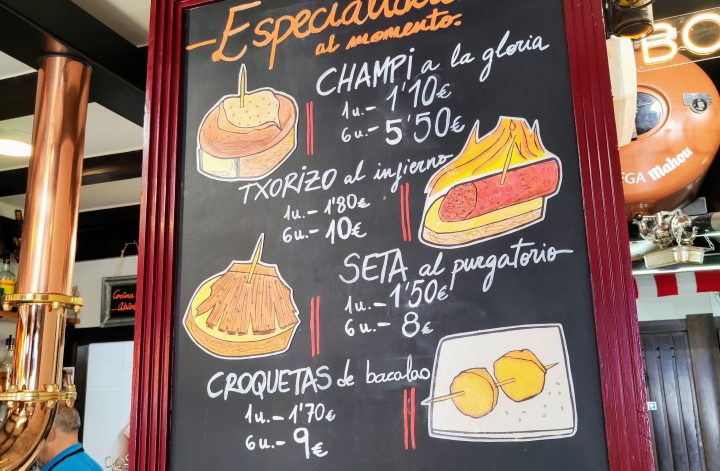Txakoli (also known as Txakolina or Chacolí) is a white wine originating from the Basque Country, which is light, dry, and slightly sparkling. For many Basques, txakoli is like the nearby Cantabrian Sea: slightly salty, slightly sparkling, cooling, but you’ll fall in love with it instantly. Txakoli is a traditional Basque wine that you rarely come across outside the Basque Country.
Txakoli is characterized by high acidity, low alcohol content (usually around 10-11%), and gentle, refreshing bubbles (it naturally sparkles, not carbonated with CO₂). When tasting, you can expect fresh notes of citrus, green apples, and herbs. Due to its lightness and freshness, txakoli is an ideal wine for hot Spanish days, perfectly complementing tapas and, of course, pintxos.

Traditionally, txakoli is served very chilled and poured from a height into wide glasses to enhance its natural fizz and to aerate it more. This unusual way of serving has become a beloved ritual in Basque bars and restaurants.

Txakoli is made from local Basque grape varieties such as Hondarribi Zuri and Hondarribi Zuri Zerratia (although txakoli is associated with white wine, you can also find red and rosé variants). These grapes thrive in the unique microclimate of the region, which is influenced by the proximity of the Atlantic Ocean.
The gastronomic pairing possibilities for txakoli are diverse. This wine pairs wonderfully with local Basque specialties, especially fresh seafood, grilled fish, and local cheeses. Its freshness and acidity help balance the flavors of many Basque dishes.
The History of Txakoli Wine
The history of txakoli wine production dates back to the Middle Ages, with the first written mentions of this wine appearing in the 16th century. In the past, txakoli was primarily produced for local consumption and was often enjoyed in traditional Basque village pubs called “txokos.” However, during the 20th century, txakoli production began to decline, and by the 1980s, txakoli was almost on the verge of extinction. A significant turnaround occurred in the 1990s when a group of dedicated winemakers and producers began working on reviving and promoting this wine. Modern winemaking techniques were introduced, grape varieties were revitalized, and stricter quality standards were established.
As part of this revival, three protected designations of origin (DOP – Denominación de Origen Protegida) were also established for txakoli:
- Getariako Txakolina DOP: Established in 1989, it includes vineyards in the Getaria area in the province of Gipuzkoa.
- Bizkaiko Txakolina DOP: Established in 1994, it includes vineyards in the Bizkaia area.
- Arabako Txakolina DOP: Established in 2002, it includes vineyards in the Araba (Álava) area.
These DOPs set strict regulations for the production of txakoli, including permitted grape varieties, maximum yields, minimum alcohol content, and other aspects of winemaking. The DOP designation helps ensure the quality and authenticity of txakoli wine.

If you are planning a trip to the Basque Country, definitely do not miss the opportunity to taste txakoli right at the source. Visit local wineries, walk through the vineyards, and experience authentic Basque hospitality. Many wineries offer tours and tastings where you can learn more about the history and production of this unique wine.
And if you don’t have the time to visit a winery, at least order a glass of txakoli in one of the local establishments, perhaps during the local ritual of txikiteo, where you go from one bar to another.
Cheers, and drink responsibly!


